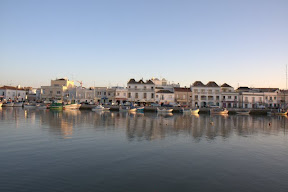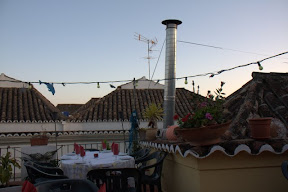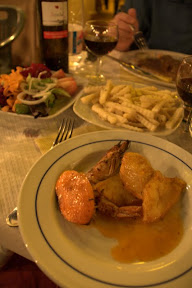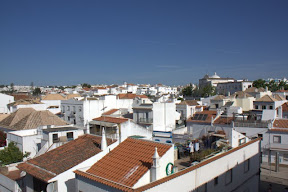Nude Beach
 |
| From Western Algarve |
The Algarve area of Portugal is tailor made for exploring due to the many beaches lining the southern coast of Portugal. As you go west, many of the beaches are tucked in between rocky cliffs. After Tavira, we headed west to Salema, a small fishing village in the southwest corner of Portugal, upon the recommendation of our friends Brad and Rachel. We used Salema as a base to explore the other beaches. Salema itself is located down a green meandering country road that leads to the ocean. (Unfortunately, most of my pictures of the town were the ones located on the camera card in our stolen camera, but I do have some.)
Since our hotel room had a small refrigerator, counter, knife, cutting board and a couple of dishes we took advantage and made some of our own meals. It also had a corkscrew, allowing us to get our own bottle of Portuguese green wine for under 3 euros. Since the Algarve is renowned for its seafood, we made sure to eat out one night and tried cataplana, a delicious and flavorful stew with fish, shellfish, tomatos, peppers and lots of spices cooked in special cookware.
We spent one day beach-hopping. Unlike the crowded, commercial or residential beaches at home, most of the land leading up to the beaches is protected and undeveloped. We drove down country roads lined with wildflowers, never sure what type of beach would pop up at the end. We happened to hit on the best one first. Tucked into between rocky cliffs, the sand was softer than the beach we visited on an island in Tavira. We found a spot between some beach rocks and listened to the waves crash up against the rocks. The Atlantic Ocean’s waters were still too nippy to do much swimming, but some people surfed in wet suits. Sean and a few other swimmers braved the waters for a quick swim.
It didn’t take long to figure out that the beach was divided into segments. Closest to the road, families with children made sand castles and frolicked in a pool of water leftover from high tide. Further down, it seemed to be mostly adults. Like the beach at Tavira, some, but not all, of the woman chose to go topless. But at the end of the beach – the most scenic part next to the rocky cliff – we quickly realized that many people, both men and woman, were full on nude. The men in particular seemed to strut up and down the sand in this section of the beach, scholongs waving back and forth. The funny part about nude beaches is that most of the people who are nude or topless aren’t the ones you probably would want to see. In case you were wondering, we both don’t feel the need for a head to toe tan. With my luck, I’d get a nasty sunburn in a place where the sun doesn’t normally shine.
Three Favorites in Tavira
Because of our delayed departure from Morocco that randomly placed us in the middle of Andalucia, we ended up meandering around Andalucia instead of following our original plan. So when we ended up in Seville, where a car was a hindrance instead of a help, we weren’t sure where to go to put our car to good use. We wanted to see the eastern part of Andalucia such as Granada and Costa del Sol, but it seemed our car would get in the way. Plus, we were less than 2 hours from Portugal’s border. In the end, the call of a new country beckoned too loudly, so we headed west. It fascinates me still that you can cross a country’s border just as easily as if you passed from Pennsylvania to Ohio.
We landed in Tavira, one of the first towns along Portugal’s Algarve region. Our friends Brad and Rachel recently visited Portugal and were smitten with the Algarve, and we could see why. Supposedly in July and August this area is overrun with tourists. While we weren’t the only visitors, it seemed like the perfect time to visit, as it was not crowded but the weather was warm and sunny (in the 80s) each day.
Tavira is a small little town with good vibe. It is not right on the coast, and you have to take a ferry to the beach, which is located on a nearby island. A small river runs through town, with pedestrian bridges leading you to each side. The buildings lining the river shine with the sunlight and reflect their images onto the water. Many of the buildings in town are white with red roofs, and those that are not are covered in colorful Portuguese tile. There seemed to be many ex-pats who have settled there, such as the British B&B owners, the shop owner from Wales, and the German woman running the Laundromat.
| From Eastern Algarve |
We sensed a strong UK presence. We saw magazines geared to British tourists, pubs with British and Irish beers, and English on all of the menus. Many of the tourists spoke English, but with a much different accent than our English. A waiter wanted to know where our unique accent was from, because we didn’t sound like the others. He said he didn’t see many people from the United States. We’ve heard that many tourists skip Portugal because it is just a sliver of land bordering Spain, and there is so much to see in Spain. While we love Spain, Portugal was fun and different and definitely worth seeing in its own right.
Some of our favorite things about this trip so far are located in Tavira. Every meal we had in Tavira was good, but our dinner at Restaurante Patio stood out. We ate dinner up on the terrace. The prawns I ordered were huge, and interspersed between grilled vegetables, sausage, and juicy chunks of pineapple. They were brushed with nothing more than a few spices, olive oil, and the pineapple juice. Sean equally enjoyed his traditional Portuguese dish, some sort of steak with a flavorful sauce. Unfortunately, although we heard rumors of Portugal being cheap, we found the meals to be more expensive than many of the meals we had in Spain. This is mostly because they practically force feed you starters. They will bring starters and charge you for them, whether you order them or not. There is a charge for bread, a charge for butter, a charge for cheese, a charge for olives, a charge for sardine pate, and a charge for marinated carrots (this charge I could forgive, because they were tasty).
Tavira also had a number of cute shops, but again, one stood out in particular. Casa das Portas is a small shop, but it is chock full of many treasures. Every direction in which you looked was filled with beautiful objects. I wanted to buy the whole store. Between the bags, the wall hangings, the pictures of Tavira’s doors taken by the owner, the scarves, and the jewelry, I was in heaven. The whole shop was filled with color. You can take a trip around the world right in the shop, because many of the items are from artists around the world. The owner, Jane Gibbons, told me she tries to buy items that are fairly traded. The owner is a very sweet and helpful woman with an adorable accent. She is originally from Wales. She began visiting Tavira a number of years ago, and opened the shop in 2007. She went out of her way to show me all of the options, and even volunteered that a necklace I was looking at came in a smaller, less expensive version in case I wanted to spend less.
I made a separate trip back without Sean so I could spend time lingering over all of the beautiful things in the store. To Sean’s dismay (but not surprise) I did not walk out empty handed. In my defense, we were headed to the beach later that day, and if I had not bought a purple and rose striped tote bag from London, we would have had to bring our small backpack and gotten it all sandy. It also came in handy for our trips to the grocery store for our picnic lunch. In my further defense, it is not like we planned to visit Columbia, so I could not have bought the bright, multi-colored necklace made from tagua (vegetal ivory) and dyed with natural dyes anywhere else. Nor was Indonesia a definite on our list, so the purple three strand bracelet made from coconut shells was a good buy. Believe me, only purchasing three items was restraint. If the multi-colored beaded or silver necklaces from an Australian artist hadn’t been over a hundred euros, I might have given them serious consideration. And then there was the spiral wall hanging made from recycled paper in Brazil…if only it wasn’t too big to fit in the backpack.
We also loved the place where we stayed. We did not have a guidebook for Portugal, and picked a hotel/B&B on a whim. We are very glad we did. The place where we stayed, Residencial Hotel Por do Sol, is hands down the best place we stayed so far. It had everything but a hairdryer. (I’ve only encountered about 4 or 5 hairdryers on this trip. Except for Matt’s Parisian apartment, all of the hairdryers have been puny, wimpy ones – nothing to get excited over). We had booked a room on the terrace, but Miguel, the owner, upgraded us for no charge into a bright and sunny room on the second floor. The room was stylish, and had a desk and two chairs in addition to the comfortable bed. (It gets very old having nothing but a bed to sit on all of the time). We had a television with English speaking channels. We had a balcony, which even came with a clothesline so we could dry our laundry in the sun as the Portuguese do. We had a small refridgerator. And after a stretch of many rooms without wifi at all or only in a common area, it was glorious to have wifi right in our room. The hotel was in walking distance to all of the shops and restaurants of Tavira, and Miguel was full of advice about places to eat in Tavira and things to do in the Algarve. Breakfast (fresh squeezed orange juice, coffee, croissants, meats and cheeses, and fruit salad) was served on the terrace overlooking Tavira’s rooftops. The best part? The room was only 44 euros per night (about $55).
We didn’t want to leave Tavira, and considered staying another night. But then the internet went down, so we headed West (you know, out Californee way) to get us some internet.
The Bull Murders
It is not as if I didn’t know what was going to happen at a bullfight. I mean, I knew bulls were going to die right in front of me. Sometimes the bulls kill the matador instead, Sean said helpfully. Great. My alternatives are watching people torment an animal, or watch the animal turn on the people.
Yet I was willing to go to the bullfight, because although you can sit in cafes all over the world, bullfighting is a strong cultural tradition most famously associated with Spain. Plus, I figured I condone the murders of innocent animals each time I eat meat, even if in my ideal world the animal lives a happy little life beforehand. I’m no angel.
Again, because we are cheap frugal, we opted for the cheap seats in the sun for 13 euros per ticket instead of upwards of 30 euros for tickets in the shade. Turns out that like the spectators, matadors like the shade too, so in exchange for having the sun beat down onto us, there was a greater distance between me and the live killings that were about to occur.
Sean busied himself taking live action shots. Don’t worry. Although it meant I was forced to live through the killings a second time, I screened all of the shots to not subject you to any of the ones with stabbing, goring, or blood. There were three matadors on the poster advertising the fight. We naively assumed we would only have to watch 3 bull “fights,” but turns out there were six bulls murdered that night. The crowd never grew tired of the show.
Each time, a bull would be released into the ring. It would stumble around, looking confused. Then one of the matadors would entice it to come over with a pink cape, and the bull would take off running. They would egg the bull on for a while, provoking it to charge at the pink capes, until a man on a horse would come out. The bull would take all of its anger out at the horse and charge at its side. The horse, who was blindfolded by the way, would stumble around while the rider on top stabbed at the bull with a long sword. Fortunately, the horses now wear armor. For a time, more horses were killed in bullfights than bulls.
After being weakened by its stabbing from the rider atop the horse, the bull continued to charge at the matadors. They taunted the bull, enticing it to come closer, until each of them stabbed two colorful pointed sticks (banderillas) into the bull’s neck. Sometimes, one of the two would bounce off the bull and land on the ground, but the end result was that the bull would run around, raging mad, with 4-6 banderillas dangling from its body.
Finally, a matador would come out with a red cape. When the bull charged at the cape, the matador raised a giant sword and thrust it in the bull’s neck, going for the kill shot. If it didn’t work, the matador would repeat until the bull stumbled and collapsed on the ground. Just to make sure the job was really done, one of the other matadors gave the bull a few final stabs. Horses dragged the bull’s lifeless body away to the cheers of the crowd, leaving a trail of blood in the sand. The blood was swept over, and the process began again.
I can’t begin to fathom why this is something that people enjoy, but to each his own, I suppose. It is safe to say that this will be the one and only bullfight I attend in my life.
p.s. When we were eating dinner at a little hole in the wall restaurant in Lisbon, Portugal, we noticed they were showing a matador collapsed on the ground on t.v. At first I thought it was the news and a bull had killed a matador. Then we realized it was a t.v. show – something along the lines of C.S.I., Lisbon. All of the characters were there: there was the older, wise detective, the young hot head, and the attractive female. They studied the crime scene, went to the morgue, and interrogated suspects. The only difference was the murder. The murder was of a matador, killed by two banderillas in his neck. A classic Iberian whodunnit.
Not a good day.
Yesterday was another one of those bad travel days. Not every day is good at home, so it stands to reason that not every day will be good on the road.
Yesterday was bad because our SLR camera was stolen and I lost my sunglasses. Double whammy.
When we returned back to our room last night, I realized I no longer had my sunglasses. I suspect I left them sitting on the table where we had dinner earlier in the evening. The sunglasses were only $20 from Marshalls, but considering I use them every single day, I’ll be missing those a lot.
Even worse is the stolen camera. We are in Lisbon, Portugal. Lisbon is full of quaint trolleys, and the 28E takes you up and down Lisbon’s hills through its different neighborhoods. Unfortunately, the trolleys are also hotbeds for petty crime. One moment our camera was between us on the seat, and the next, after we stood up, it was gone. Some advise not to take fancy cameras on the road for this reason, but we always figured that if you are not going to use a fancy camera when you are travelling the world, when would you use it? Out of all the items we carry with us, the camera was by far the most expensive. And we lost more than the camera: we lost the zoom lens we upgraded, the Crumpler camera bag we purchased for the trip, the green polka-dotted camera strap from Etsy.com, the 8 gig memory card, and the two filters we never quite figure out how to use. And our room keys.
Luckily, we only lost about a day’s worth of photos because I try to upload our pictures to our camera every day or so. We are trying not to get too upset about it, but I can’t help but feel that I lost a limb, as we have been carrying the camera around everywhere. We have insurance, so hopefully it will cover the loss. And we have another camera, a little point and shoot, so it is not like we will be pictureless. But still. Not a good travel day, for sure.
The All Elusive Authenticity.
Like most tourists that visit Seville, we wanted to see two of the things for which Seville is best known: flamenco dancing and bullfighting.
According to the all knowing on the Internet, there are many ways to see flamenco. There’s the dinner and a show approach at a tablao, all packaged up neatly for tourists. The advantage is that the dancers are supposedly superb and decked out in full costumes. The disadvantage is that the shows feel a little touristy, and are expensive: upwards of 35 or 40 euros per person. There’s also smaller performances at neighborhood bars, many of which are impromptu and often cost no more than the price of your drinks. The advantage is the more intimate setting and the lower cost; the disadvantage is that sometimes the shows are more low-key. One person analogized viewing flamenco shows like this: you can see Buddy Guy at a large arena show with lots of other people, or an unknown blues band at a local bar. The Buddy Guy show is classic blues and technically superior, but the experience at the local bar is likely more authentic.
It really wasn’t that much of a choice for us due to our new frugal lifestyle. Our google searches revealed the name of a bar supposedly renowned for their free flamenco shows – La Carboneria. By the looks of it, everyone else did the same google search. Walking down a dark narrow street off a more lively one, I heard someone say behind us, We’re supposed to look for a red door. Is that a red door? No, I think that’s more orange. Oh, there it is! The instructions on Google mentioned that the bar was not marked and to look for a red door. It sounded very mysterious and exciting, which it may have been, had at least 3 or 4 other groups of people not been looking for the same thing.
Though we arrived early, crowds were already packed in on the picnic benches. Around 11:00 p.m., a woman and three men came to the front of the room. Two played the guitar and one played the flute while the woman twirled and danced. She wore a green print dress that she hiked above her knees. She did not have a lot of room to move. She stomped around and waived her arms as a sweat broke out on her clavicle. The performance lasted only about 30 minutes. I heard a daughter next to me say to her mother, Mom, you’ve only seen flamenco on cruise ships. This is different. This is authentic.
The performance wasn’t quite what I imagined, but I was intrigued and I wanted to see more. Sean was done with “this flamingo dancing.” I talked him into taking a cab across the river to Triana for another show starting at midnight anyway.
Triana is supposed to be the “birthplace” of flamenco, and I read online that Anselma’s was one of the better places in the city to see casual, impromptu flamenco. So did at least 100 others. When we arrived, there was a huge line waiting to get into the bar before midnight when the “show” started. Meanwhile, there already were people occupying every seat at every table. Anselma finally opened up the gate, and the line of people streamed into the bar. When we finally came to a halt, I couldn’t move. There were people standing within inches of me on all sides, and still more people struggled to get by. Anselma made herself known, pushing past people to insist that they get a drink. Occasionally, people we were more important than Sean or me were escorted to premier spots in the bar. One was apparently such a VIP that Anselma booted two people out of their seats and cleared the way for a guy in a suit and his date. Huh. Guess we should suited up, as our backpacker clothes were not getting us any special treatment.
We lasted for one drink and couldn’t take feeling like a sardine in a can anymore. We didn’t see anyone dance, but heard some people play music that sounded excellent. So much for our “authentic” flamenco experience…stay tuned for our bullfighting experience which was a little too authentic for my liking.











